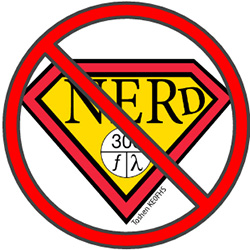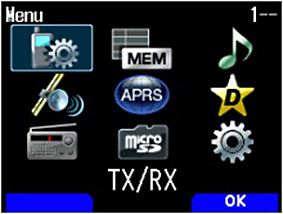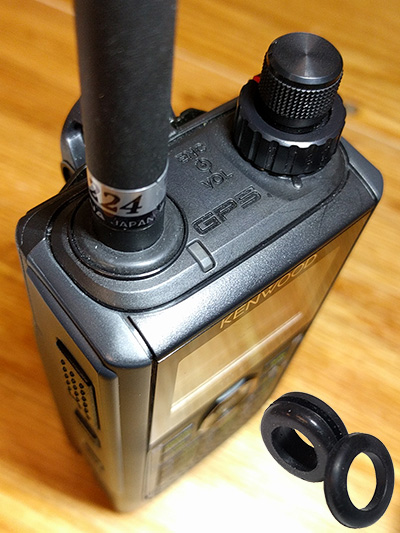How To Register A Dstar Radio For Use On Repeaters
Diving into D-STAR – ii
CC BY-SA![]()
2) Choosing a way forward
Given all the interesting options that are available, how do yous really choose which combination of radio, hotspot, and software to apply?

Fork in a woodland path
past MarclSchauer, Shutterstock![]()
For me, this involved offset doing lots of reading and watching lots of videos (see Links to helpful resources![]() on the Notes folio at the terminate of this article).
on the Notes folio at the terminate of this article).
Then an Elmer tutored me. A shout out to the late Starr Aldrich, N0AES, of the Longmont Amateur Radio Club![]() , who generously spent a skillful scrap of fourth dimension patiently answering my questions.
, who generously spent a skillful scrap of fourth dimension patiently answering my questions.
Next I came beyond some enthusiastic hams in southern Colorado, the Parker Radio Clan![]() , who are doing lots of fun digital radio-related work. Their site helped me gain a broader perspective about digital radio.
, who are doing lots of fun digital radio-related work. Their site helped me gain a broader perspective about digital radio.
The Charlotte Digital Radio Group![]() is another grouping doing amazing piece of work with digital radio and posting good data. See their Contents
is another grouping doing amazing piece of work with digital radio and posting good data. See their Contents![]() page.
page.
Finding all of these resource was a bit similar being tossed a life saver … I was even so in the soup, but at least my head was finally above water!
Equally ane of my Elmers, George, KA0BSA, says, "When people ask me what ham radio is, I say it is a learning bend."
2a) Answering iii key questions
One of the principal things I've learned is that choosing a correct fashion forrard comes down to answering a few key questions, the most important of which is:
1) Which systems do the people you want to talk with use?
Because the various digital vox systems tin be largely incompatible, in many cases you'll want to exist using the aforementioned system every bit the people y'all want to talk to. Knowing which base organisation you desire to focus on can help you eliminate hotspots that don't support that organization.
Beyond that, as much as is possible I'd likewise like the flexibility to explore other systems, so the next key question is:
ii) How shut to the cutting edge can you travel comfortably?
On i end of the spectrum is today's earth of personal technology, which pretty much spoils us. The most complicated affair we need to practice is figure out which Bone we desire to buy into. And then nosotros simply download and install some apps and at most tweak a few easy settings. Later that, it all pretty much just works.
On the other end of the spectrum are the SuperNERD geniuses designing and soldering their own boards, writing their own apps, and putting upwards repeaters.
Alas, I'm not a SuperNERD. While I'm willing to practice some exploring closer to the cutting edge, I also know I should avoid solutions whose descriptions include terms like "experimental" or that require SuperNERD powers.

For case, the description of an early on iteration of a multi-fashion modem board in one of the PRA presentations says: "Requires deep experience in compiling and configuring software, and interfacing with hardware." Nope, not for me.
There'southward one final question I remember is worth because:
three) Is the technology open?
For what it'south worth, I prefer open applied science. When engineering science is open, more people can review information technology and contribute to its improvement and security. People also can use open engineering science more easily to experiment and innovate.
This means I prefer DV radios and reflector systems that are open up to those that are proprietary and closed. I also prefer a hotspot that enables me to connect to multiple different reflectors over one that limits me to a proprietary organisation.
The openness cistron is one I always carefully weigh when making decisions about the technology in which to invest my time and money. I even so use proprietary solutions, merely all other factors being relatively equal, I adopt an open one.
How would the Trojans have reacted if the Horse statue the Greeks gave them was fabricated of drinking glass and they could see correct through it? They would have seen the malicious implants and removed them before letting the statue into their enterprise. That is my fundamental thought about open-source software. Everyone can examine the code and look for and remove vulnerabilities….
Bob Gourley, Cognitio co-founder, former Defence Intelligence Agency CTO
2b) Before doing annihilation else
There are a couple registration processes that can have a few days to complete, so it's a good thought to go them started equally shortly equally you tin.
i) Register with the D-STAR Gateway System
To fully apply the gateways on many D-STAR repeaters, yous demand to register with the D-STAR Gateway Arrangement, a organisation that shares callsign routing and other information across all the D-STAR repeaters within the system. Information technology's easy enough to register, and so it'southward worth doing this right abroad.

- Read the D-STAR Self Registration Instructions
 .
. - Notice the D-STAR repeater nearest to yous that processes registrations. Come across the D-STAR Info website'due south repeater list
 . Note: If you don't take a local gateway system to register with, you lot tin use D-STAR Gateway System (REGIST)
. Note: If you don't take a local gateway system to register with, you lot tin use D-STAR Gateway System (REGIST) .
. - It's of import to register only in one case and with only 1 D-STAR Gateway. Your registration will be shared across the system. Once more: THIS IS Of import! If you register with two gateways, it tin can actually mess things up for you when you first trying to use D-STAR.
- When y'all register, you tin add together up to viii radios, each distinguished by an initial that follows your callsign, so that when you transmit, the radio y'all're using can be identified.
- The first radio y'all register must be your callsign followed by an "initial" that is a blank space: use your spacebar to insert a bare space.
- It'southward totally optional whether y'all annals whatever other radios beyond the outset one; in fact, some people call up adding multiple radios confuses things and can crusade issues, so they recommend against it.
- The RPT option is used ONLY for registering repeaters. You lot can utilise your own callsign to run a hotspot, which are Non considered repeaters.
- Once your registration has been processed, double-check that you registered everything correctly: DStar-Gateway Registration Check
 .
.
ii) Optionally, register with CCS7 for DCS (and DMR)
If you're going to be using the DCS reflector system (or DMR), you as well need to annals with an authentication and routing arrangement called CCS7 (Callsign Advice System, 7-digit).
The DCS system uses the CCS7 ID number instead of your callsign, though its authentication service maps your CCS7 ID number to your callsign. The CCS7 system is now the hallmark system for multiple systems.
Registrations for everywhere—including Northward America, South America, Asia, and Oceania, Europe, and Africa—are now all handled by RadioID.net![]() .
.
The registration systems are administered by volunteers so be patient, information technology can accept a few days to receive your CCS7 ID.
2c) Choosing a D-STAR-capable radio
There are a bunch of good D-STAR radios bachelor from Icom![]() and Kenwood
and Kenwood![]() .
.
Because of my good experience with the Kenwood TM-V71A mobile radio, when I started getting curious about exploring D-STAR and so saw that Kenwood had released a new D-STAR-capable HT, the TH-D74A![]() , I was intrigued.
, I was intrigued.

I suspected the TH-D74A might be a expert choice for me, especially when I saw that the characteristic set likewise includes APRS with congenital-in GPS. Also nice: tri-band, bluetooth and USB connectivity, and IP54/55 weatherproofing. And it has a color screen, which isn't really necessary, just sure is sweet.
One time I got my hands on this radio, I apace grew to similar it. I find the way the interface is organized, especially the carte du jour system, really easy to use.

I did swap out the stock prophylactic duck for a Comet HT-224![]() . However, i thing I didn't like about the new antenna was that, because it is thinner than the stock one, it left a gap between the radio's antenna seat (5/8″ ID) and the HT-224 (3/8″ OD). I solved that by getting a $0.26 prophylactic gasket (3/8″ ID × v/8″ OD × i/sixteen″ groove) at our local hardware store.
. However, i thing I didn't like about the new antenna was that, because it is thinner than the stock one, it left a gap between the radio's antenna seat (5/8″ ID) and the HT-224 (3/8″ OD). I solved that by getting a $0.26 prophylactic gasket (3/8″ ID × v/8″ OD × i/sixteen″ groove) at our local hardware store.

I sliced off one side of the gasket with a razor blade, and it makes a perfect seal: it fits snugly around the antenna, and likewise fits down in the antenna seat opening prissy and tightly. Sometimes, yous simply get lucky! I recall the gasket will assistance preserve the radio's IP54/55 weatherproofing, and it looks better, also, making the antenna expect similar a more natural part of the radio.
I think this radio is going to give me years of opportunities to explore and savour many areas of analog and digital communication.
2nd) Choosing a hotspot
I then needed to decide which hotspot to use. That's when all the great information from Elmer Starr likewise as some of the online info I came across really helped. 1 thing Starr recommended was to endeavor a solution based on the petty Raspberry Pi![]() (RPi) computer, as there are several hotspot boards and USB sticks that work with it. That struck me as a good management to caput since I had never played around with an RPi and have wanted an alibi to attempt ane out.
(RPi) computer, as there are several hotspot boards and USB sticks that work with it. That struck me as a good management to caput since I had never played around with an RPi and have wanted an alibi to attempt ane out.

Equally Thorin Klosowski writes in his Lifehacker.com article, What I've Learned From Tinkering With the Raspberry Pi for Five Years![]() :
:
[T]he Raspberry Pi is far, far away from beingness as user friendly as a PC or Mac. That's a feature, not a bug. The Raspberry Pi is built to force you to learn troubleshooting, and that'south still one of my favorite things about it.
And then I got an RPi 3B, and started tinkering with it. By default, it runs Raspbian OS![]() (Raspbian is a version of Debian Linux that was created for the Raspberry Pi). I'chiliad quite impressed with what this little credit card-sized computer can do. It even includes my favorite function suite, LibreOffice
(Raspbian is a version of Debian Linux that was created for the Raspberry Pi). I'chiliad quite impressed with what this little credit card-sized computer can do. It even includes my favorite function suite, LibreOffice![]() . Nice!
. Nice!
Then I turned my attention to the hotspot itself. In that location are many combinations of hotspot devices and software being adult by innovative hams, many of which back up multiple digital voice systems including D-STAR, DMR, YSF, P25, NXDN, POGSAG, and multiple cross modes.
This is such a big topic that I've spun off an entire commodity describing how hotspots work and discussing the many available choices: Hanging out with hotspots![]() .
.
Have fun choosing!
< Page 1 · Page 3 >
Source: https://amateurradionotes.com/d-star-2.htm
Posted by: townsendhowles1955.blogspot.com


0 Response to "How To Register A Dstar Radio For Use On Repeaters"
Post a Comment